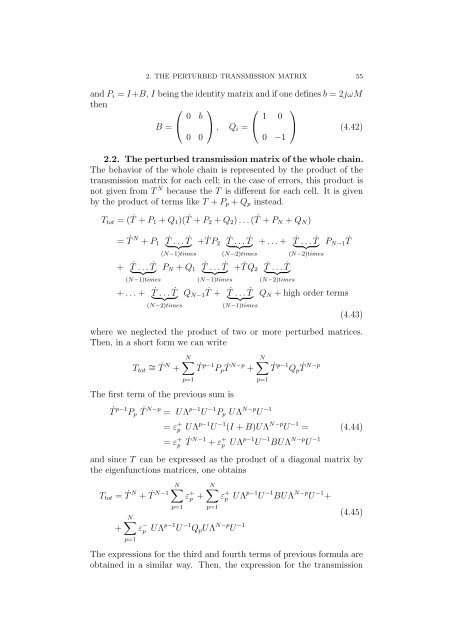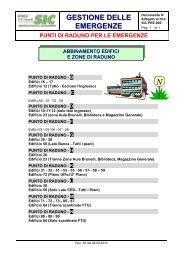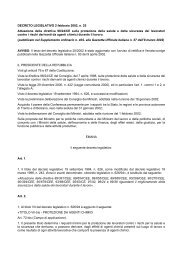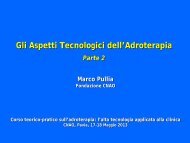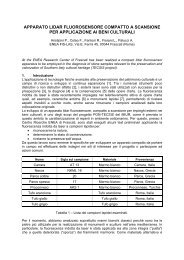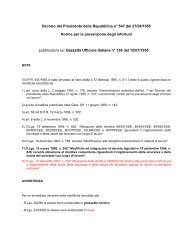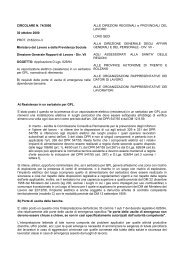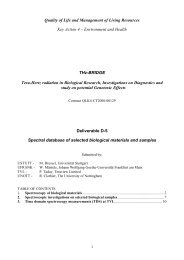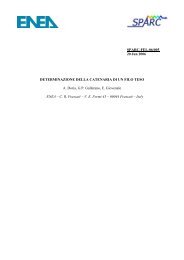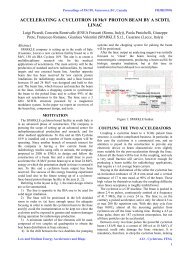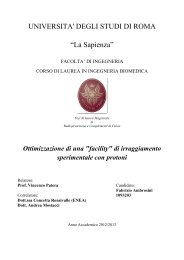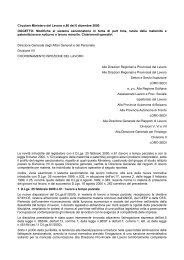Theory, Design and Tests on a Prototype Module of a Compact ...
Theory, Design and Tests on a Prototype Module of a Compact ...
Theory, Design and Tests on a Prototype Module of a Compact ...
You also want an ePaper? Increase the reach of your titles
YUMPU automatically turns print PDFs into web optimized ePapers that Google loves.
2. THE PERTURBED TRANSMISSION MATRIX 55<br />
<str<strong>on</strong>g>and</str<strong>on</strong>g> Pi = I+B, I being the identity matrix <str<strong>on</strong>g>and</str<strong>on</strong>g> if <strong>on</strong>e defines b = 2jωM<br />
then<br />
⎛<br />
0<br />
B = ⎝<br />
0<br />
⎞<br />
b<br />
⎠ ,<br />
0<br />
⎛<br />
1<br />
Qi = ⎝<br />
0<br />
⎞<br />
0<br />
⎠<br />
−1<br />
(4.42)<br />
2.2. The perturbed transmissi<strong>on</strong> matrix <strong>of</strong> the whole chain.<br />
The behavior <strong>of</strong> the whole chain is represented by the product <strong>of</strong> the<br />
transmissi<strong>on</strong> matrix for each cell; in the case <strong>of</strong> errors, this product is<br />
not given from T N because the T is different for each cell. It is given<br />
by the product <strong>of</strong> terms like T + Pp + Qp instead.<br />
Ttot = ( ˙<br />
T + P1 + Q1)( ˙<br />
T + P2 + Q2) . . . ( ˙<br />
T + PN + QN)<br />
= ˙ T N + P1 T ˙ . . . ˙<br />
T<br />
+<br />
(N−1)times<br />
˙ T P2 T ˙ . . . ˙<br />
T<br />
+ . . . +<br />
(N−2)times<br />
˙ T . . . ˙<br />
T<br />
PN−1<br />
(N−2)times<br />
˙ T<br />
+ ˙ T . . . ˙<br />
T<br />
PN + Q1 T ˙ . . .<br />
(N−1)times<br />
˙<br />
T<br />
+<br />
(N−1)times<br />
˙ T Q2 T ˙ . . . ˙<br />
T<br />
(N−2)times<br />
+ . . . + ˙ T . . . ˙<br />
T<br />
QN−1<br />
(N−2)times<br />
˙ T + ˙ T . . . ˙<br />
T<br />
QN + high order terms<br />
(N−1)times<br />
(4.43)<br />
where we neglected the product <strong>of</strong> two or more perturbed matrices.<br />
Then, in a short form we can write<br />
Ttot ∼ = ˙<br />
T N +<br />
N<br />
T˙ p−1 Pp ˙ T N−p +<br />
p=1<br />
The first term <strong>of</strong> the previous sum is<br />
N<br />
T˙ p−1 Qp ˙ T N−p<br />
p=1<br />
T˙ p−1 Pp ˙ T N−p = UΛ p−1 U −1 Pp UΛ N−p U −1<br />
= ε + p UΛ p−1 U −1 (I + B)UΛ N−p U −1 =<br />
T˙ N−1 + ε + p UΛ p−1 U −1 BUΛ N−p U −1<br />
= ε + p<br />
(4.44)<br />
<str<strong>on</strong>g>and</str<strong>on</strong>g> since T can be expressed as the product <strong>of</strong> a diag<strong>on</strong>al matrix by<br />
the eigenfuncti<strong>on</strong>s matrices, <strong>on</strong>e obtains<br />
Ttot = ˙<br />
T N + ˙<br />
T N−1<br />
+<br />
N<br />
p=1<br />
N<br />
ε + p +<br />
p=1<br />
N<br />
p=1<br />
ε − p UΛ p−1 U −1 QpUΛ N−p U −1<br />
ε + p UΛ p−1 U −1 BUΛ N−p U −1 +<br />
(4.45)<br />
The expressi<strong>on</strong>s for the third <str<strong>on</strong>g>and</str<strong>on</strong>g> fourth terms <strong>of</strong> previous formula are<br />
obtained in a similar way. Then, the expressi<strong>on</strong> for the transmissi<strong>on</strong>


